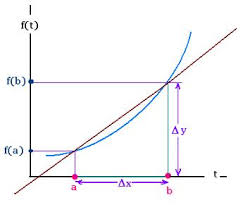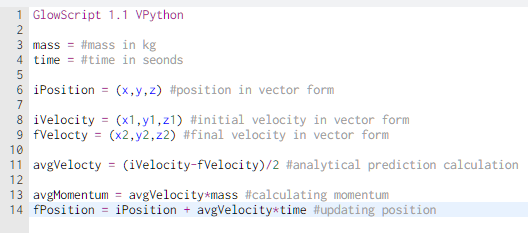Analytical Prediction: Difference between revisions
| Line 24: | Line 24: | ||
[[File: Htmpng2.png|600px]] | [[File: Htmpng2.png|600px]] | ||
Not only does this code show how to use the analytical prediction method using python/GlowScript, it also shows how you can use that average velocity to calculate the momentum and update the position. These are the typical calculations associated with prediction methods. | |||
==Examples== | ==Examples== | ||
Revision as of 14:10, 3 December 2015
By Hayden McLeod (hmcleod6)
The Main Idea
Analytical prediction uses a mathematical function that can describe the position or velocity of a system at any given time. In contrast to iterative prediction, this means that there is no need to make multiple calculations at small steps in order to find a solution. However, due to the method of derivation of the velocity, the analytical method is only accurate to a high degree when the force applied to the system is constant. Due to this limitation, the iterative prediction method is much more generally applicable.
A Mathematical Model
Unlike the iterative prediction method which is derived directly from the momentum principle, the formula for analytical prediction is based of the formula for the arithmetic mean.

Here, X bar is the arithmetic mean, sigma f x is the sum of all the values, and sigma f is the total number of terms. Since we only need two values of velocity to calculate the average velocity, the formula, for this purpose, can be simplified.

A Computational Model
Below is a visualization of the analytical prediction of the average velocity. As you can see, it takes two points, (a, f(a)) and (b, f(b)), and finds the average between the two points. Also depicted in the image is the incapability to model non-linear curves by comparing the average slope (velocity) compared to the actual slope (velocity).

In addition, an example of using this method in GlowScript can be seen below.

Not only does this code show how to use the analytical prediction method using python/GlowScript, it also shows how you can use that average velocity to calculate the momentum and update the position. These are the typical calculations associated with prediction methods.
Examples
Be sure to show all steps in your solution and include diagrams whenever possible
Simple
Middling
Difficult
Connectedness
- How is this topic connected to something that you are interested in?
- How is it connected to your major?
- Is there an interesting industrial application?
History
Historically, it is well known that basic algebra was discovered and implemented well before calculus, especially based on the fact that algebra was used as a basis to develop calculus. For this reason, it can be assumed that the analytical approach to physics problems related to velocity, or any other changing value, was used long before the iterative method. There is no information on who would have used this approach or when this approach was first used in a physics application.
See also
Are there related topics or categories in this wiki resource for the curious reader to explore? How does this topic fit into that context?
Further reading
Books, Articles or other print media on this topic
External links
References
This section contains the the references you used while writing this page